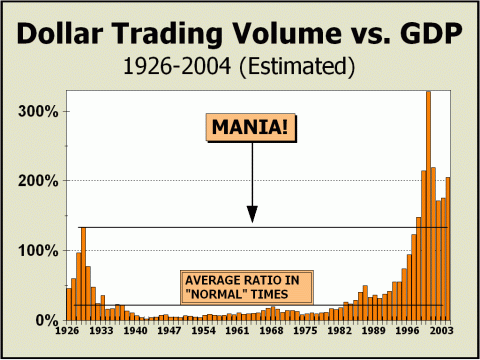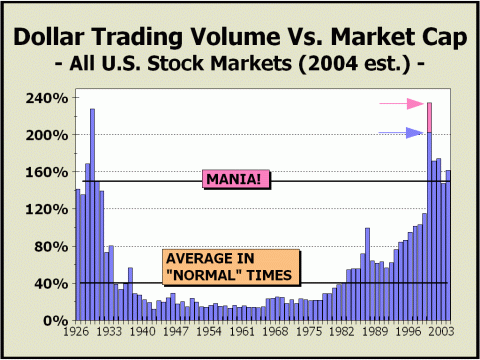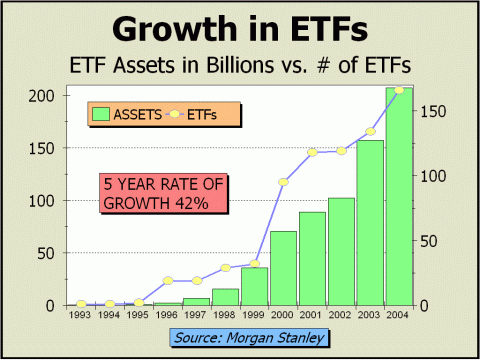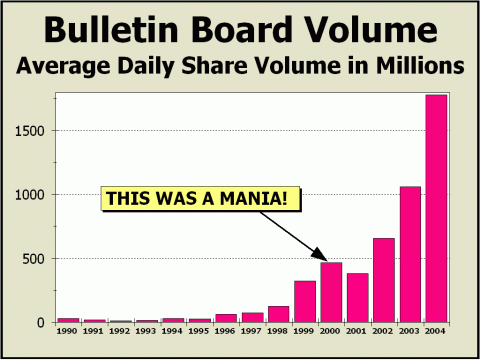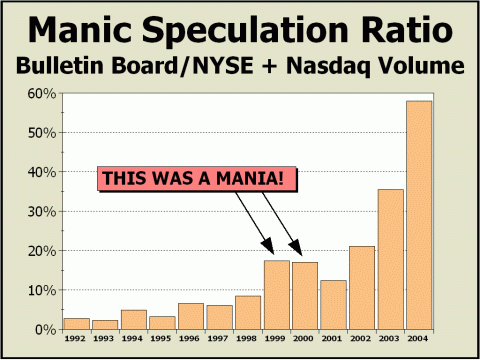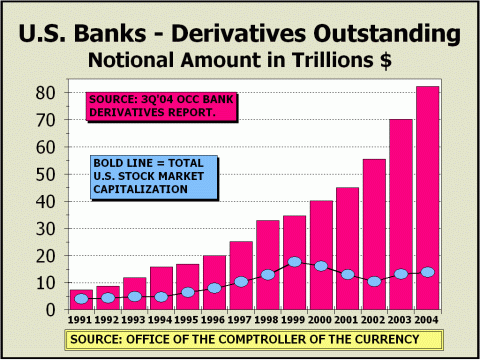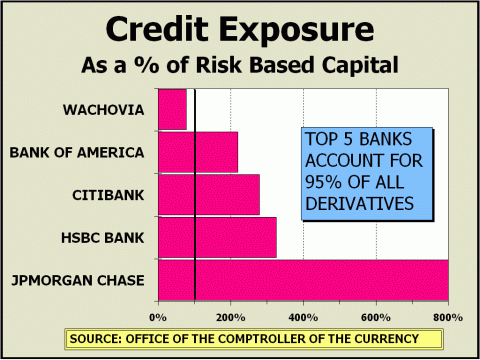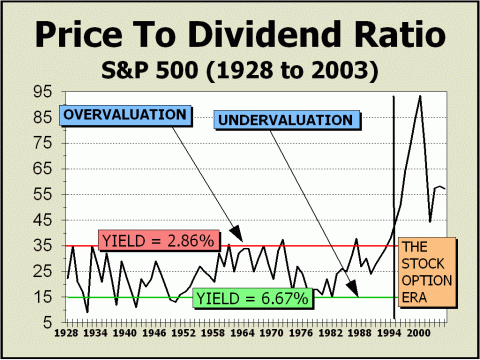
|
- THE GREATEST STOCK MARKET MANIA OF ALL TIME - DATED FEBRUARY 7, 2005 A SPECIAL REPORT BY ALAN M. NEWMAN, EDITOR SAMEX CAPITAL'S STOCK MARKET CROSSCURRENTS This feature
is now published on a quarterly basis.
|
| This is our
48th report on the ongoing mania since we first published our website on
January 15, 1999. Since that time, well over three million visitors
have perused our free offerings and well over one million have visited
this page. At first, we published monthly, then every other month,
and we now publish this feature quarterly. Make no mistake, it's
a huge task to put together a free report of this size while composing
several other free features and then to publish a paid subscription stock
market newsletter, where our only rationales for existence are powerful
commentary, unique perspectives and reality checks that cannot be found
anywhere else. We have been told far too often that we do not charge
enough for our work. We agree. If you need to know what keeps your
Editor going, check out the testimonials on our Kudos
page.
- TERMINAL VELOCITY? - Keeping track of the data has never been easy but our task is now more difficult than ever. Why? In the December 6th issue of Crosscurrents, we jokingly claimed, "Thank the top 100 Nasdaq issues that are no longer the 'Qubes,' once symbolically noted as QQQ. The entity has proved such a voracious vacuum of cash reserves that the keepers of the flame had to add another Q to keep up with the demand, so the QQQs are now the QQQQs. A full 33-1/3% better than before." The reason for the symbol change was that trading of the Trust was shifted over to Nasdaq. Although Nasdaq publishes data for its own trading, it does not publish dollar volume trading data for the Amex, which it owns. And the Amex does not publish the data, thus we have had to make estimates for the last couple of years (up to 2002, the NYSE published data for the Amex). We believe we are well within 2% of the actual total figure for the Amex and the picture for the full year of Dollar Trading Volume for 2004 is presented below. DTV rose 26.2% from 2003 and appears headed for a test of the record high of $32.6 trillion registered in the manic year of 2000. Last year's activity was the second highest ever and coming only a scant four years since the biggest collapse in seven decades, one can only surmise that the mania must still be in play. Despite a halving of the price of the S&P 500 and a 78% drubbing in the Nasdaq Composite, traders still cannot get enough action and continue to clamor for more. DTV finished at 204.8% of Gross Domestic Product, close to the 219.1% recorded in 2001 and the 214% of 1999. If this is not the rekindling of the greatest stock market mania of all time, it is clearly an incredibly solid imitation of same. If there are any reasons why DTV did not set new records this year, it is solely due to the fact that the prices of Nasdaq's stocks are still well below their manic peaks. The proof is seen in DTV for the New York Stock Exchange, 5% higher than in 2000 and a brand new record. It is totally illogical to expect an exact
replay of the year 2000,
- "STOCKS ARE BEING RENTED" - Our second measurement pits DTV versus total stock market capitalization. In this case, activity last year would have been second only to the insanity witnessed in 2000 had market cap not expanded by more than 9% in the final quarter. We arbitrarily defined "normal" as levels of trading at 40% or under. This happens to be the precise average of all years that were not manic and in fact, of the 78 years shown, 47 fall into the normal category, including the 34 consecutive year period from 1938 to 1981. Clearly, the behavior of the markets during so long a stretch can only be termed "normal." We arbitrarily defined a "mania" as levels of trading above 149.7% registered in 1930. Thus, only six years of the last 78 qualify; 1928, 1929, 2000, 2001, 2002 and 2004. Of course, there is no actual and tangible boundary - we can easily make the case that the action in 2002 precluded a mania and that the recovery of 2003 accentuated manic behavior. The point is that speculation in the form of turnover, is now the name of the game. Investment is simply no longer an option. One proof of our conclusion is how mutual fund cash levels have contracted since the end of the 1990 bear market, from over 9% to near all time lows. In fact, the 12-month moving average of fund cash-to-assets is as low as it has been at anytime since 1985, possibly the lowest ever. Anecdotal proof is available in the amount of money traded that has nothing to do with individual common stock issues (more on that below). Finally, we offer the recently quoted wisdom of Morgan Stanley's Byron Wein. It's clear that it is not about investing anymore, it's all about trading and speculation. “In 1960....annual turnover was 12%....as
recently as 1992....annual turnover was 54%....So far in 2004....annual
turnover is 104%. We are clearly living in a more frenetic trading
environment. More and more stocks are being rented, not owned."
We typically attempt to refrain from repeating a subject covered in the most recent update, but ETFs are growing at such an incredibly rapidly pace that we are compelled to update the chart shown in November. The article below was presented in the December 6th issue of Crosscurrents. - BUYING ALL THE EGGS IN THE BASKET - Subscriber Jay Matulich asked if the huge increase in ETFs meant "....a scarce supply of stocks." Mr. Matulich, who toils for the Lexus Opportunity Fund LP, realized that between demand from mutual funds and ETF trusts, the "float" for individual companies has diminished, so we see a ramp up effect over time and even "melt up" moves on good news. Shrewd observer. Even worse, so much of U.S. equity is now indexed to one construct or another, bulls can always point to a bull market via one index or another. The S&P 500 is lagging? No problem. Point to the small caps. Small caps lagging? Point to the hot sector. There's always a bull market somewhere and in fact, folks, that's been Wall Street's trick - to connive and coerce while fleecing the sheep into the belief that a bull market is always ongoing. Even the venerable New York Stock Exchange got tired of seeing the NY Index linger and lag, so they changed it to suit the times. It's all so easy. And now, as our subscriber noted, "You get these big, mid and small caps acting like the tight float stocks," yes indeed, they now are! Look at all the ETFs that are divvying up the pie. According to Thomson Financial, there are now 1400 institutional investors holding U.S. listed ETFs! Screw analyzing individual companies - too much time, too much effort, too much risk - so buy an index or buy the market, what difference does it make? How else can valuations become as hugely bloated as in the U.S.? Let's repeat it for the umpteenth time; valuations are higher now than anytime in history except 2000. They were even lower at the manic peak in September 1929, just before the greatest stock market crash of all time. How bad has the craze become? See for yourself in our featured chart. There are now 166 separate ETFs comprising more than $207 billion in assets, trading at the rate of $13.3 billion per day! If our math is correct, one of every seven dollars traded in the U.S. stock market has nothing to do with the underlying securities, but is traded via the ETFs. Demand for ETFs also comes from overseas, such as Norway’s $140 Petroleum Fund. Knut Kjaer, head of the fund, said ETFs "have become liquid and an alternative to futures contracts." And of course, we have not yet begun to even factor in the effect of futures or options. How can anyone believe that stocks represent value in an environment when the individual corporate shares that comprise the backbone of capitalism are relegated to the status of also-rans against the mighty and powerful derivative market?! We'll scream it from the mountain tops if we need to; stock prices are compromised by the growth of derivatives, especially ETFs, which have grown at a 42% clip annually for the last five years. If you're wondering what 42% annualized growth over five years means, it's the equivalent of the NYSE trading 5.4 billion shares per day or the Dow over 66,000. This is not just rapid growth - we are witnessing a historic and full fledged phenomenon that threatens to overtake every vestige of investment sanity that remains. As Chairman of the Presidential Task Force on Market Mechanisms, Nicholas Brady reminded us in 1987, "We are looking down the barrel and the gun is still loaded." At the top of this report, we mentioned our task in compiling the data, which includes estimating DTV on the Amex. On January 24, 2005 for example, the Amex most active list included 11 ETFs in the top 20 most actively traded issues. The top five issues were all ETFs. The total dollar volume traded for just the 11 most active ETFs came to $9.35 billion that day, and at that pace, just the top five traded on the Amex would trade $2.18 trillion for 2005, nearly one in every ten dollars traded every day in the U.S. Bear in mind, we have not included the QQQQs, which by themselves will quite possibly trade more than $1 trillion in 2005. Clearly, if we include the other 161 ETFs and those that will come on stream in 2005, more than one in every ten dollars traded will NOT be individual stocks. Investing? Not any more.
- IT'S NOT ABOUT INVESTMENT - The following article was first
seen in the January 10th issue of Crosscurrents.
Our colleague and fellow technician Ralph Acampora recently penned a report entitled, "Fearless Forecast for 2005: The Cyclical Bull Accelerates Higher." The highlights of the report target an all time record high for the Dow Jones Industrials to as high as 13,300, a further 22% gain in the S&P 500 and another 30% inflation of the Nasdaq Composite. Wow. We're impressed. Forget the fact that modest earnings gains on the order of 10% accompanied by the same increase in dividends paid out would take the S&P up to a 23.2 P/E multiple in a rising rate environment and lower the dividend yield to 1.54%. None of this makes any sense to us, but what do we know? We have already seen the greatest stock market mania of all time unfold before our very eyes, why not a huge echo of the very same madness that drove valuations well beyond anything ever seen in all of stock market history? Thus, by using mirrored "measured moves" from an earlier cyclical bull market that occurred within a secular bear market circa 1970-1973, Mr. Acampora posits the targets offered above are within reach. Our problem with the report is any comparison of this cyclical bull market as part of a secular bear with any cyclical bull that occurred before - since the present cyclical bull market still sits solidly on the back of participants who have lost all comprehension of value and simply do not INVEST either their own money nor clients' money. This is not your father's stock market anymore. Turnover is so robust that the investment process has been completely replaced by the ultimate metric - performance via trading. Valuations have been so far out of whack for so long that professionals no longer believe that they are out of whack. What was inconceivable just a decade ago is now routine. Even with five interest rate hikes and more on the horizon, stocks can trade at literally any multiple and yield almost nothing in comparison to bonds. Worse yet, because valuations have lost their meaning, sentiments about the future have been enabled beyond all reason and optimism has risen to extremes as crazy as any ever seen. Perhaps the echo of the mania is seen best in the activity generated on the OTC Bulletin Board. Monthly data was finally updated after a recess dating from August, but the data seem incorrect, showing a drastic contraction in share volume for September & October while evidencing an increase in dollar trading volume and total transactions for the same period. Nevertheless, we’re reporting what we found. At the rates generated through the first 11 months of the year, total shares traded have exceeded the manic peak of 2000 by a factor of 3.8 and have increased rapidly since the brief fallout experienced in 2001. Apparently, the folks who buy penny stocks were no more discouraged by their experience than those professionals who are still eager to "invest" in stocks at valuations that cannot possibly hold up over time.
Perhaps most striking is that those who play the garbage penny stock market have increased their action dramatically versus trading on the NYSE and Nasdaq. Even in the mania’s most insane moments in 1999 and 2000, bulletin board volume was only a small fraction of the combined trading on NYSE & Nasdaq. Now it is 56.4% of the big two, up from 35.5% in 2003, and apparently headed for equality. Remember, for Bulletin Board issues, “There are no minimum quantitative standards which must be met by an issuer….” Forget earnings. Even sales are not necessary. If these two charts are not
graphic evidence of an echo of the mania,
- DERIVATIVE MANIA IN FULL BLOOM - We try to cover the derivative environment twice a year in the hope that our continued exposure will lead to greater comprehension of the systemic risks the markets incur. Although derivatives supposedly reduce risk for individual parties, these risks are then laid off again and again down a daisy chain of counter parties. No one knows how long the daisy chain is nor precisely who is involved, not the banks, not the regulators and not the government. The chain is so convoluted and complex that there is no way of computing all the interactions. As well, there is no readily available method to measure the "hedgedness" of all contracts accurately on a daily basis. It is entirely possible that we only find out after the stuff hits the fan. The perfect example was the fall out from the Long Term Capital Management fiasco in 1998. And if the Federal Reserve had not quickly stepped in to broker a deal between the counter parties, there is no telling what might have occurred. Meanwhile, derivative growth continues unfettered by any attempts to regulate or to define which risks are tolerable and which are not. At the end of 2000, the total notional value of derivative contracts for insured commercial banks in the U.S. was $40.1 trillion, two-and-a-half times the total market capitalization of the stock market and four times the total generated by our Gross domestic Product. As of the Third Quarter of 2005, the total notional value of derivative contracts for insured commercial banks in the U.S. was $82.3 trillion, six times the total market capitalization of the stock market and seven times the total generated by our Gross domestic Product. To place the numbers in another perspective, let's compare them to the Dow. From the beginning of 1995, when we pinpoint the birth of the mania until now, the Dow would have to be trading near 21,000 to grow at the same rate as derivatives have in the last decade. At some point, something has to give. Four times GDP in 2000. Seven times GDP last year. Is there a limit?
Although we have not yet suffered a irrevocable fallout from the few major derivative events that have taken place like the crash of 1987 and LTCM, that time will come. It must. All markets, no matter how sophisticated, no matter how mature, no matter how reasonable, have eventually witnessed a worst case scenario based upon unforeseen developments. In 1987, it was the cascade effect of portfolio insurance. In 1998, it was the collapse of Russian government paper. Tomorrow's event? We only know that an event will eventually occur, a circumstance that is totally unexpected, a situation that roils the markets. If that event forces the collapse of an entity that is as exposed to credit risk as the banks you see represented on our chart, what are we to believe?
- IT'S NOT ABOUT DIVIDENDS EITHER - For the first 67 years covered by this chart, the price-to-dividend ratio ranged from roughly 15 to 35. If stocks traded down below a 3% yield or thereabouts, watch out, a bear market was probably on the way. If stocks traded to over a 6% yield, pile it on, a bull market was surely around the corner. Then in 1995, we are supposed to believe that all the rules changed and a new paradigm was born. Stocks need not pay dividends any more and the valuation measure that had served investors so faithfully for more decades than we can show, was summarily kicked out the door. Although strategists and analysts were more than ready to rationalize the new paradigm, it is obvious in retrospect that it was all about stock options. Executive compensation soared in the mania and was driven principally by stock options. For stock options to work best in favor of executives, companies had to pay out less in cash for dividends. Whatever a company paid out was gone from the corporate treasury. Whatever the company kept in the treasury meant the shares had to be worth more. How else can you explain the sudden and utter disappearance of benchmarks that had functioned perfectly for so long? In fact, the S&P's dividend payout ratio topped in 1992 at just over 50% and was still 49% when the "new paradigm" commenced. The ratio dropped like a stone to as low as 26% on 2000 and was 30% as recently as last year (the ratio is currently 36%). Although we would certainly hesitate to bless the new paradigm's potential to endure, for the sake of argument, let's assume it will. We'll further assume that the boundary that used to mark overvaluation will in the future, mark UNDERvaluation. The P/D ratio is currently 57.22. Let's presume a bullish scenario where dividends rise 10% per year for five years and it takes the same five years for stocks to return to the "under" valued boundary. S&P 500 Dividends, currently $20.85, would rise to $33.58. At a 35 P/D ratio, the S&P 500 would then trade at 1175, lower than today! Of course, it doesn't have to work out that way. If the "under" valued benchmark is achieved in three years, the S&P 500 would trade down to 971, almost 20% below today. Of course, if we're wrong, it might be that the historic benchmarks will once again be in play. If so, watch out! Given 10% increases in dividends over the next decade, the historical undervaluation parameter would be achieved in 2015 by the S&P 500 at 811, more than 35% down from today.
Since 1928 and until the mania commenced, dividends accounted for 47.5% of all gains for investors. Even as the mania and stock options curtailed dividends and speculation increased, dividends since 1928 have still accounted for 40.7% of all gains. But in a rising interest rate environment like now, it is becoming more and more difficult to justify a new paradigm. Right now, dividends imply that it's not about investing anymore - dividends still do not count for much. We believe that will all change in the next few years.
High
Targets for 2005 - these are now very low odds except for SPX):
Low
Targets for 2005 - these are now very low odds except for SPX):
Long
Term Targets for ultimate bear market low - now most likely to occur in
2006
THE CONTENTS OF THE ENTIRE WEBSITE ARE COPYRIGHT 2005 ALAN M. NEWMAN I hope you have enjoyed your visit and please return again. If you know anyone who might be interested in seeing what we have to offer, we'd be happy to have them visit as well! Alan M. Newman, February 7, 2005 All information on this website is prepared from data obtained from sources believed reliable, but not guaranteed by us, and is not considered to be all inclusive. Any stocks, sectors or indexes mentioned on this page are not to be construed as buy, sell, hold or short recommendations. This report is for informational and entertainment purposes only. Samex Capital, Alan M. Newman and or a member of Mr. Newman’s family may be long or short the securities or related options or other derivative securities mentioned in this report. Our perspectives are subject to change without notice. We assume no responsibility or liability for the information contained in this report. No investment or trading advice whatsoever is implied by our commentary, coverage or charts. |
